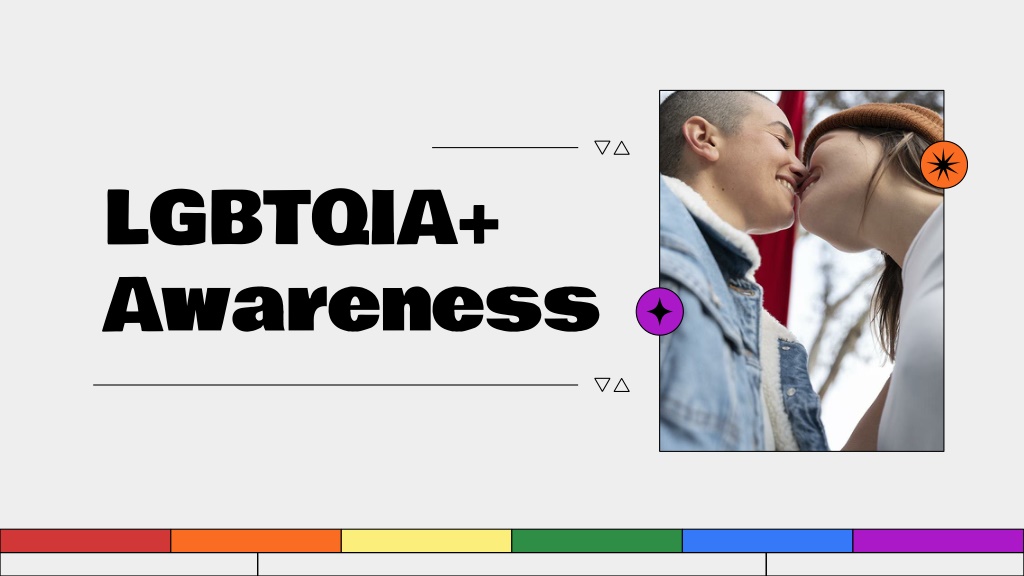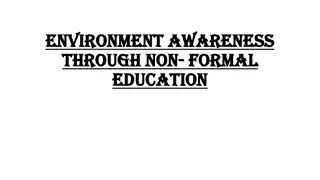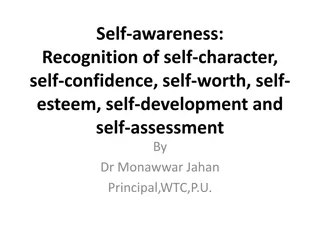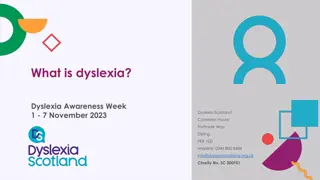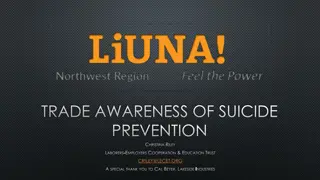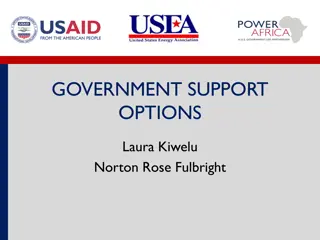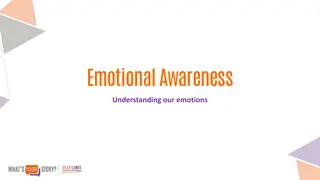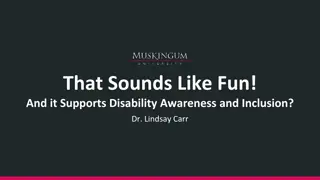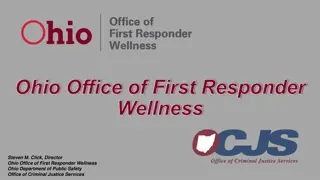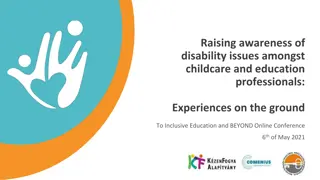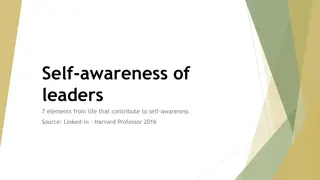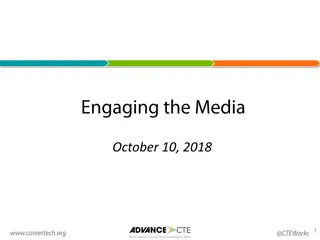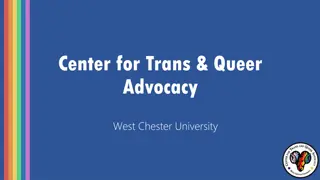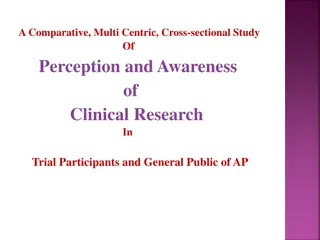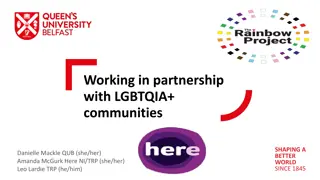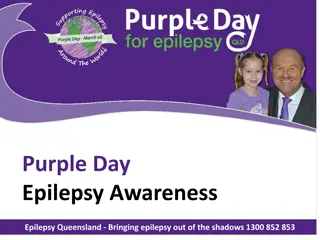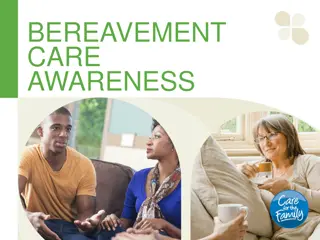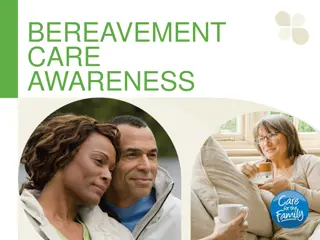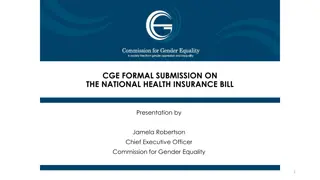Understanding LGBTQIA+ Awareness and Support
Delve into the meaning of LGBTQIA+, common questions, sex vs. gender distinctions, and ways to support the LGBTQIA+ community. Explore topics like appropriate language use, mental health concerns, and resources for LGBTQ+ awareness. Gain insights on supporting individuals through transitioning and challenges faced by transgender individuals in various settings.
Uploaded on Sep 24, 2024 | 0 Views
Download Presentation

Please find below an Image/Link to download the presentation.
The content on the website is provided AS IS for your information and personal use only. It may not be sold, licensed, or shared on other websites without obtaining consent from the author. Download presentation by click this link. If you encounter any issues during the download, it is possible that the publisher has removed the file from their server.
E N D
Presentation Transcript
LGBTQIA+ Awareness
You should have a better understanding of Meaning of LGBTQIA+ Common Questions/Concerns?? Understanding SEX vs. GENDER Use of appropriate words when investigating incident What to do if you misuse a pronoun Mental Health concerns amongst LGBTQIA+ Ways to support the LGBTQIA+ community Resources LGBTQ+ Awareness
What does LGBTQIA+ stand for? L= Lesbian G= Gay B= Bisexual T= Transgender Q= Queer/ Questioning I= Intersex A= Asexual LGBTQ+ Awareness
Common Questions Is this just for the training or do they actually use the LGBTQIA acronym out there. Do they refer to themselves as LGBTQIA? As a group of people? Do you know if this percentage of LGBTQIA people that commit suicide are people that are out or not yet? When someone is transitioning and going through their physical change at what point can they change their identity on their license and such? LGBTQ+ Awareness
Common Questions What would be your recommendations on communicating empathy when it s borderline between a hate crime and freedom of speech? One thing that I come across on a regular basis is a man who is dressing as a woman. How do I articulate this person in a simple and straightforward way while completing a report, radio transmission, etc? Talking about searches, and dealing with strip searches. Policy states they have to have same gender, so this presents unique challenges for transgender individuals. LGBTQ+ Awareness
Sex vs Gender A person's sex and gender are NOT the same thing! Sex is the classification of a person as male or female. This sex assignment at birth is typically based solely on one s genitals. Gender describes the internal experience of being a man, a woman, a nonbinary person, or otherwise. Every person experiences gender differently and you cannot know someone s gender by simply looking at them. *The Trevor Project LGBTQ+ Awareness
*Equitas Health Love is love
Common Genders Cisgender: people whose gender identity aligns with the sex they were assigned at birth. Transgender: people whose gender identity differs from the sex they were assigned at birth. Some folks might choose to receive certain gender affirming care but this is not necessary and each person should be allowed to choose what works best for themselves. Nonbinary: an umbrella term to describe people who experience their gender identity and/or expression outside of the male/female/ man/woman binary, including folks who are genderfluid, genderqueer, polygender, bigender, demigender, agender, and many others. *The Trevor Project LGBTQ+ Awareness
How to be Respectful Using preferred names- shows acceptance and support Using correct pronouns (she/her, he/him, they/them) Avoid assumptions- use gender neutral language when unsure Instead of Boyfriend/Girlfriend - Use Partner/Significant Other Instead of Husband/Wife - Use Spouse Instead of Boys/Girls - Use Friends, Folks, Everyone, Kids Instead of Daughter/Son - Use Child Instead of Brother/Sister - Use Sibling Most of the time people are understanding that mistakes happen. If you refer to someone as the wrong name or use the wrong pronoun, acknowledge your mistake and try your best to correct yourself in the future. *The Trevor Project LGBTQ+ Awareness
Why is it Important to Get Pronouns Right? *Human Rights Campaign LGBTQ+ Awareness
Suicide Facts & Risk Factors LGBTQ+ young people are more than four times as likely to attempt suicide than their peers (Johns et al., 2019; Johns et al., 2020). The Trevor Project estimates that more than 1.8 million LGBTQ+ young people (ages 13-24) seriously consider suicide each year in the U.S. and at least one attempts suicide every 45 seconds. Risk factors: Lack of support Physical harm/bullying Discrimination *The Trevor Project LGBTQ+ Awareness
Mental Health Risk Factors ANXIETY/DEPRESSION Anxiety and Depression are the most reported clinical diagnosis's 67% of LGBTQ youth reported experiencing symptoms of anxiety (2022 74%) 54% of LGBTQ youth reported experiencing symptoms of depression (2022 58%) The Trevor Project 2023 LGBTQ+ Awareness
Mental Health Risk Factors LGBTQ+ Awareness
Mental Health Risk Factors LGBTQ+ Awareness
Mental Health Risk Factors 60% of LGBTQ youth reported that they have experienced discrimination based on their sexual orientation.(2022 65%)* 51% of transgender and non-binary youth reported that they have experienced discrimination based on their gender identity.(2022 61%)* Youth and Adults higher risk with self medicating and later on addition (prescription, illicit drugs, alcohol) *The Trevor Project 2023 LGBTQ+ Awareness
Personal & Community Barriers Lack of support (School, Work, Police, First Responders, Community, Peers, Parents/Gaurdians, legal system, laws). Lack of/access to resources (Therapists, LBTGQIA+ Organisations, Support Groups) 24% of LGBTQ youth reported that they have been physically threatened or harmed due to either their sexual orientation or gender identity.*(2022 36%) 18% of LGBTQ youth reported that they have been physically threatened or harmed due to their sexual orientation.*(2022 31%) 27% of transgender and non-binary youth reported that they have been physically threatened or harmed due to their gender identity.*(2022 37%) Stigma *The Trevor Project 2023 LGBTQ+ Awareness
5 Ways You Can Support The LGBTQIA+ Community Listen- take the time to listen and learn from the LGBTQIA+ community. Be a role model- don t tolerate any kind of hateful speech, speak up for kindness and inclusion Allow people to be authentic around you, be open and accepting of differences Take action- know what resources you can offer, empower others to be understanding and empathetic Stay informed- keep current on local and world events as well as laws/policies specific to this population *Human Rights Campaign LGBTQ+ Awareness
Resources www.thetrevorproject.org www.nami.org Youth Text Start 678-678 Call 1-866-488-7386 National Suicide Prevention Line (800) 273-8255 (online chat available) Crisis Text Line Text START to 741-741 Trans Lifeline (877) 565-8860 LGBTQ+ Awareness
